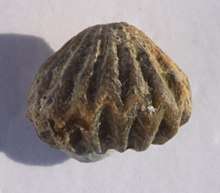Bloyd Formation
The Bloyd Formation, or Bloyd Shale, is a geologic formation in Arkansas. It preserves fossils dating back to the Carboniferous period.
| Bloyd Formation Stratigraphic range: Pennsylvanian | |
|---|---|
 Fossil from the Bloyd Formation | |
| Type | Formation |
| Sub-units | Baldwin coal,[1] Brentwood Member, Dye Shale Member, Kessler Limestone Member, Parthenon Sandstone Member,[2] and Woolsey Member[3] |
| Underlies | Atoka Formation |
| Overlies | Hale Formation |
| Lithology | |
| Primary | Shale |
| Other | Sandstone, limestone |
| Location | |
| Region | Arkansas |
| Country | United States |
| Type section | |
| Named for | Bloyd Mountain, Washington County, Arkansas[4] |
| Named by | Albert Homer Purdue |
Stratigraphy
The Bloyd Formation conformably overlies the Hale Formation and unconformably underlies the Atoka Formation. Five formal and one informal members are recognized in the Bloyd Formation (in stratigraphic order):
- Kessler Limestone Member
- Dye Shale Member
- Parthenon Sandstone Member (also known as the "middle Bloyd sandstone")[5]
- Woolsey Member
- Baldwin coal (an informal unit at the top of the Woolsey Member)
- Brentwood Limestone Member
In the eastern parts of the Ozarks in Arkansas, the Bloyd Formation becomes undifferentiated with the underlying Hale Formation and is called the Witts Springs Formation.
Paleontology
Bryozoans
|
|
|
Cephalopods
|
|
|
|
Conodonts
|
|
Crinoids
|
|
|
|
Flora
- A. missouiense[13]
- Cuneiphycus
- C. aliquantulus[13]
- Donezella[13]
- Eflugelia[13]
- Girvanella[8]
- G. minuta[13]
- Paraepimastopora[13]
- Stachedoides
- S. spissa[13]
Foraminifera
|
|
|
References
- Croneis, Carey (1930). "Geology of the Arkansas Paleozoic area" (PDF). Arkansas Geological Survey Bulletin. 3. Archived from the original (PDF) on 2017-01-25. Retrieved 2018-01-28.
- Chandler, Angela; Zachry, Doy (2010). "Parthenon Sandstone: a prominent new member of the Morrowan Bloyd Formation, Pennsylvanian of north-central Arkansas (abstract)". Geological Society of America Abstracts with Programs. 42 (2): 70. Retrieved 28 January 2018.
- McFarland, John David (2004) [1998]. "Stratigraphic summary of Arkansas" (PDF). Arkansas Geological Survey Information Circular. 36: 14. Archived from the original (PDF) on 2016-12-21. Retrieved 2018-01-28.
- Purdue, A. (1907). "Description of the Winslow quadrangle". U.S. Geological Survey Geologic Atlas of the United States. 154: 2, 3.
- Chandler, Angela; Zachry, Doy (2010). "Parthenon Sandstone: a prominent new member of the Morrowan Bloyd Formation, Pennsylvanian of north-central Arkansas". Geological Society of America Abstracts with Programs. 42 (2): 70. Retrieved 27 May 2018.
- Henry, Thomas W.; Sutherland, Patrick K. (1977). "Brachiopod biostratigraphy of Morrowan series (Pennsylvanian) in northwestern Arkansas and northeastern Oklahoma" (PDF). Oklahoma Geological Survey Guidebook. 18: 107–115. Retrieved 1 February 2018.
- Horowitz, Alan S. (1977). "Late Mississippian and Early Pennsylvanian bryozoan faunas of Arkansas and Oklahoma: a review" (PDF). Oklahoma Geological Survey Guidebook. 18: 101–105. Retrieved 3 February 2018.
- Nodine-Zeller, Doris E. (1977). "Microfauna from Chesterian (Mississippian) and Morrowan (Pennsylvanian) rocks in Washington County, Arkansas, and Adair and Muskogee Counties, Oklahoma" (PDF). Oklahoma Geological Survey Guidebook. 18: 89–99. Retrieved 3 February 2018.
- Saunders, W. Bruce; Manger, Walter L.; Gordon Jr., Mackenzie (1977). "Upper Mississippian and Lower and Middle Pennsylvanian ammonoid biostratigraphy of northern Arkansas" (PDF). Oklahoma Geological Survey Guidebook. 18: 117–137. Retrieved 1 February 2018.
- Gordon, Jr., Mackenzie (1964). "Carboniferous cephalopods of Arkansas" (PDF). U.S. Geological Survey Professional Paper. 460: 40–45.
- Grayson Jr, Robert C.; Sutherland, Patrick K. (1977). "Conodont evidence for unconformity within Trace Creek Shale Member of Bloyd Formation (Lower Pennsylvanian) in northwestern Arkansas and northeastern Oklahoma" (PDF). Oklahoma Geological Survey Guidebook. 18: 181–184. Retrieved 30 January 2018.
- Strimple, Harrell L. (1977). "Chesterian (Upper Mississippian) and Morrowan (Lower Pennsylvanian) crinoids of northeastern Oklahoma and northwestern Arkansas" (PDF). Oklahoma Geological Survey Guidebook. 18: 171–176. Retrieved 30 January 2018.
- Groves, John R. (1983). "Calcareous foraminifers and algae from the type Morrowan (Lower Pennsylvanian) region of northeastern Oklahoma and northwestern Arkansas" (PDF). Oklahoma Geological Survey Bulletin. 133: 65. Retrieved 3 February 2018.
- Knox, Larry W. (1977). "Morrowan (Lower Pennsylvanian) ostracodes from Arkansas and Oklahoma" (PDF). Oklahoma Geological Survey Guidebook. 18: 139–147. Retrieved 31 January 2018.
- Sohn, I. G. (1977). "Late Mississippian and Early Pennsylvanian ostracoda from northern Arkansas - a preliminary survey" (PDF). Oklahoma Geological Survey Guidebook. 18: 149–159. Retrieved 31 January 2018.
- Rigby, J. Keith; Manger, Walter L. (14 July 2015). "Morrowan lithistid demosponges and hexactinellids from the Ozark Mountains of northwestern Arkansas". Journal of Paleontology. 68 (04): 734–746. doi:10.1017/S0022336000026184.
- Branson, Carl C. (May 1961). "New records of the Scyphomedusan Conostichus" (PDF). Oklahoma Geology Notes. 21 (5): 130–138. Retrieved 28 January 2018.
- Various Contributors to the Paleobiology Database. "Fossilworks: Gateway to the Paleobiology Database". Archived from the original on 31 July 2014. Retrieved 8 July 2014.
This article is issued from Wikipedia. The text is licensed under Creative Commons - Attribution - Sharealike. Additional terms may apply for the media files.